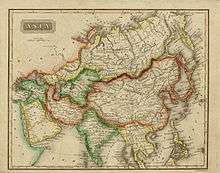Sidney Edwards Morse
Sidney Edwards Morse (7 February 1794 Charlestown, Massachusetts – 24 December 1871 New York City) was an American inventor, geographer and journalist. He was the brother of telegraphy pioneer and painter Samuel F. B. Morse.
.jpg)
Biography
He was the son of geographer and clergyman Jedidiah Morse. He graduated from Yale in 1811, studied theology at Andover Seminary, and law at the Litchfield, Connecticut, school. Meanwhile, he became a contributor to the Columbian Centinel of Boston, writing a series of articles that illustrated the danger to the American Union from an undue multiplication of new states in the south, and showing that it would give to a sectional minority the control of the government. These led to his being invited by Jeremiah Evarts and others to found a weekly religious newspaper, to which he gave the name Boston Recorder. He continued as sole editor and proprietor of this journal for more than a year, and in this time raised its circulation until it was exceeded by that of only two Boston papers. Morse was then associated with his elder brother, Samuel Morse, in patenting the flexible piston pump and extending its sale.

In 1823 he moved to New York, and with his brother, Richard Cary Morse, founded the New York Observer, which eventually became the oldest weekly in New York City, and the oldest religious newspaper in the state. He continued as senior editor and proprietor until 1858, when he retired to private life.
In 1839 was associated with Henry A. Munson in the development of cerography, a method of printing maps in color on the common printing press. He used this process to illustrate the geographical textbooks that he published, and in early life he assisted his father in the preparation of works of that character. The last years of his life were devoted to experimenting with an invention for the rapid exploration of the depths of the sea. This instrument, called a bathometer, was exhibited at the World's fair in Paris in 1869, and during 1870 in New York City.
Literary works
- A New System of Modern Geography (Boston, 1823), more than half a million copies of which were sold
- Premium Questions on Slavery (New York, 1860)
- North American Atlas
- Cerographic Maps, comprising the Whole Field of Ancient and Modern, including Sacred, Geography, Chronology, and History
References
- This article incorporates text from a publication now in the public domain: Wilson, J. G.; Fiske, J., eds. (1900). . Appletons' Cyclopædia of American Biography. New York: D. Appleton.
External links
| Wikimedia Commons has media related to Sidney Edwards Morse. |
- 1844 map of Texas and 1856 map of Texas by Sidney E. Morse, hosted by the Portal to Texas History.
- Works by or about Sidney Edwards Morse at Internet Archive